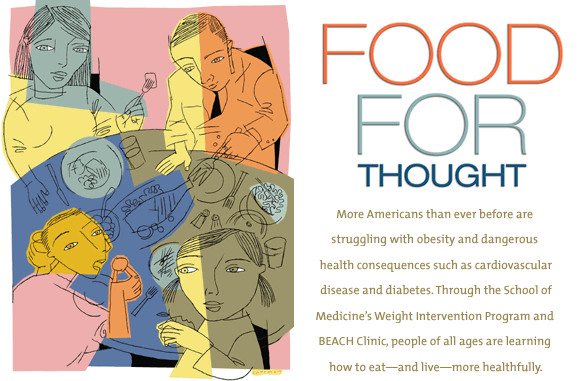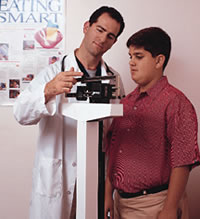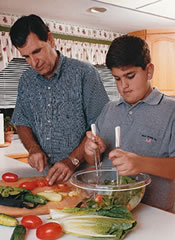 |
||||||||||||
|
|
||||||||||||
|
The result? Twenty-five percent of American children are overweight, and 11 percent are obese—at least 30 pounds over a healthy weight. One day obesity will be classified as a disease with treatment covered by insurance. But today overweight children, teens, and adults struggle against economic, societal, and cultural obstacles to improving their health. “The mindset needs to change,” says Jennifer Marks, M.D., associate professor of medicine and medical director of the Weight Intervention Program at the University of Miami School of Medicine. “Just like alcoholism, being seriously overweight is not about weakness or willpower, it is a disease. Society and insurance providers need to acknowledge that, if the situation is ever going to change.” By adulthood, a staggering 61 percent of Americans are overweight, according to the U.S. Department of Health and Human Services. And that has severe medical consequences. “The most serious health concerns associated with obesity are cardiovascular disease and diabetes because of the complications these patients incur,” says Marks, a diabetes specialist. “Something like high blood pressure can be controlled, but when people get diabetes at 15 instead of 45, that gives them decades in which to develop terrible complications.”
At the University of Miami’s BEACH Clinic (Better Eating and Activity for Children’s Health), physicians, dieticians, and psychologists work with overweight children, teens, and their families. The clinic’s yearlong program helps young people identify and maintain activities and behaviors that can help them out of a dangerous situation.
“For some, food is almost a vice,” says Robert Kramer, M.D., pediatric gastroenterologist and director of the BEACH Clinic. “But while our bodies do perfectly fine without other vices such as cigarettes, alcohol, or drugs, it is impossible to go without food. You simply cannot go cold turkey on food. Children who have become obese need to be treated with the same mindset as any other chronic illness. Chronic disease requires ongoing treatment and monitoring—a long-term approach toward changing behaviors and helping these kids and their families unlearn unhealthy habits and move toward being more active.” Today’s overweight children have more obstacles than simply health risks to overcome. These kids and their families also face safety issues that can impact their ability to overcome sedentary lifestyles and latchkey situations. Regardless of where they live, many parents don’t feel comfortable giving their kids the freedom of decades past to walk to local parks or ride bicycles without adult supervision. Alan Delamater, Ph.D., director of pediatric psychology and head of the behavioral and family therapy component of the BEACH Clinic, says when personal safety impacts an overweight child’s ability to combat his or her obesity, it becomes a public policy issue. “Physical activity and urban design go hand in hand,” he explains. “Studies have shown lower rates of obesity in cities with designs that promote more pedestrian activity.” Kramer uses Denver as an example. “It seems like there is a park every three blocks,” he says. “People are very active, and their environment promotes that with bicycle trails and hiking paths throughout both the mountain areas and cities. I’ve had a mom say to me, ‘Hey, my kids can’t go out until I get home from work and can be with them. They can’t go out and play alone.’ Until both small and large cities commit to better sidewalks, better parks, and better after-school programs, this situation will continue.” University experts have found that South Floridians’ opinions on the importance of weight control vary widely according to ethnic background, age, and experience. |
||||||||||||
 |
||||||||||||
| The acculturation process for immigrants can
breed a fast-food mentality, especially when feeding one’s family
was an arduous, time-consuming task in rural, less-developed countries.
The sight of a typical U.S. supermarket and its easily prepared foods
causes many new residents to develop a quick affinity for processed foods.
For their teenagers, fast food is “cool.”
“Many grandmothers and older females have difficulty understanding why foods they have cooked their entire lives are now seen as unhealthy and the cause of weight gain,” says Onelia Lage, M.D., adolescent medicine specialist. “In Cuba and many other Caribbean and Latin American countries, grandmothers often did cook with lard, but their families likely worked hard on farms all day and if they needed to go to the nearest town, it may have been a three-mile walk. There was also a greater emphasis on ‘real’ food, such as meat, fruit, starchy vegetables, and milk, which are healthier but take longer to prepare. Fast foods and processed foods combined with inactivity are the more likely culprits in families that acculturate to our fast-paced society.”
In these regions, thin kids are seen as malnourished, so from birth, children are encouraged to eat often and eat a lot. If the families immigrate to the United States, Lage says this thinking often leads to a “clean the plate” syndrome, which translates into difficulty self-regulating portion size. Children are sometimes reminded of people “back home” who are hungry and told that food should never be wasted. U.S. cultures have their own share of contradicting perceptions regarding weight. Some African-Americans associate higher weight with status, especially when being heavy can represent power and leadership in a family matriarch, Kramer says. “Studies have shown that these women clearly have a good sense of self-image and a much higher threshold before they ever see themselves as heavy.” For teenagers, being thin brings very different suspicions among their neighbors, depending on where those adolescents live. “If you’re a middle- or upper-middle-class teen who is especially thin, you may be seen as anorexic,” says Lage. “If you live in an unsafe, inner-city community and you’re too thin, there may be suspicions of HIV. Those are the perceptions we hear in our practice. “Many HIV-positive kids already overweight want to continue gaining to keep people from suspecting their HIV status and to avoid being stigmatized and ostracized for having AIDS,” Lage says. “Research also shows that in homes with domestic violence, being overweight may just be a matter of self-defense and survival.”
A new physician billing code, the classification for “metabolic syndrome,” recognizes patients seeking treatment for at least three of the following items, which are pre-diabetes conditions: high blood pressure, high triglycerides, glucose intolerance, increased waistline, and low levels of HDL, or “good” cholesterol. The code resulted from 2001 National Cholesterol Education Program guidelines. Kramer says that while society is warming up to the concerns and starting to embrace the concept that obesity is a disease, the medical community registered its vote long ago. “How do you define a disease? It is any deviation or interruption of the body’s normal function that is characterized by a set of symptoms that result in predictable, measurable medical problems. Under that definition, obesity already is a disease.” |
||||||||||||
|
|
||||||||||||
|
||||||||||||
|
|
||||||||||||
|
Rebecca Morris Riordan is director of media relations
at the School of Medicine. Illustration by Whitney Sherman. Photography
by Donna Victor and Pyramid Photographics.
|
||||||||||||
|
|
||||||||||||
|
|
||||||||||||

